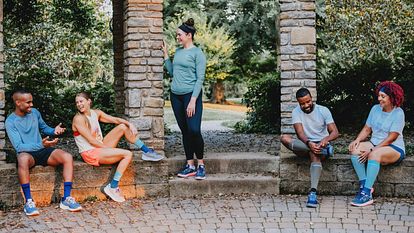“Sometimes you just have to fake it 'til you make it,” says Darcy Piceu, an elite mountain ultrarunner who lives and trains in Boulder, Colorado. “Even if you feel terrible. It’s all about your outlook.”
Piceu has run her fair share of grueling mountain races and experienced the lowest of lows smooshed uncomfortably next to the highest of highs. This is ultrarunning, and a pleasant grin goes a long way in getting you from A to B. She says smiling and a positive outlook can be the difference between a bad day and a great day, even a DNF and a win.
“When I come into aid stations, I always try to have a smile on my face,” she says. “All of those people are there to support you, so you shouldn’t be grumpy with them. And also, I know that if I’m smiling, it can really shift my outlook.”
This goes beyond the race course, too.
Deena Kastor, one of the most decorated US distance runners of all time, also expounds on the topic of happiness and racing in her recent book, “Let Your Mind Run.” Kastor makes her perspective obvious even before the first chapter. She says, in the closing line of the prologue, “Building a positive mind gives any pursuit surprising ease, lifting one to unimaginable heights …”
Kastor argues mindset is your life. If you choose to be happy during life, during training, during racing, it will shape your experience. In a 2018 interview, she told Fleet Feet that she even attributes her longevity in the sport of running to a positive attitude.
“The secret to being injury free and also having a long career is attributed to both recovery and optimism,” she says. “With recovery and optimism, my stress levels are low, my joy is high, and my desire to see myself improve is constant.”






Join our Newsletter
Get deals, events, and more.
Connect with Fleet Feet
Get involved on social media.
Find a Location
Fleet Feet has over 250 locations nationwide!
Find a Store